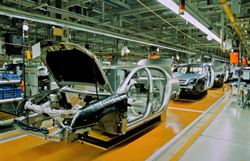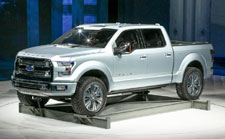Carmakers Use Less Steel to Meet Fuel Economy Standards
Daily News Article — Posted on February 15, 2013
 (by Meg Handley, USNews) – Faced with increasingly [strict requirements] – the government’s new Corporate Average Fuel Economy (CAFE) standards require a passenger vehicle fleet that averages 54.5 miles per gallon by 2025 – carmakers are taking another approach to achieving better fuel mileage: shaving weight off vehicles by experimenting with lighter materials.
(by Meg Handley, USNews) – Faced with increasingly [strict requirements] – the government’s new Corporate Average Fuel Economy (CAFE) standards require a passenger vehicle fleet that averages 54.5 miles per gallon by 2025 – carmakers are taking another approach to achieving better fuel mileage: shaving weight off vehicles by experimenting with lighter materials.
Automobiles have long been made from steel – a very strong, but heavy material. Now manufacturers are experimenting with new materials – ranging from aluminum to carbon fiber composites to metal alloys – to help companies reach the ambitious fuel efficiency standards.
“They don’t have to make these changes immediately, but there’s much more a sense of urgency now,” says Bruce Belzowski, research scientist at University of Michigan’s Transportation Research Institute. “They’ve experimented in the past with small applications, [but] now that they have to meet these [CAFE] standards [automakers] are willing to experiment and pay for materials that might be a little more expensive.”
Although a multitude of factors determine the final fuel economy performance of any vehicle, reducing weight produces beneficial effects, according to a 2008 study conducted by engineering firm Ricardo.
“A gasoline engine passenger vehicle on average could see a 0.33 percent fuel economy improvement for every 1 percent vehicle weight reduction,” David Periam, chief engineer of vehicle systems at Ricardo, wrote in an E-mail. “So for a 5 percent weight reduction, we would see a 1.65 percent fuel economy benefit and some improvement in acceleration performance.”
Right now, only select parts have been revamped with lighter materials including more flexible, shock-absorbing bumpers and roof frames, and manufactures are starting to use more plastic components to lighten heavy engine blocks. But that will likely change over the next several years as auto manufacturers take pounds off of heavier vehicles and improve fuel efficiency.
According to a recent Wall Street Journal article that cited market research firm Ducker Worldwide, the average vehicle will be 400 pounds lighter by the 2025 CAFE deadline, primarily due to doubling the use of aluminum in vehicle construction. Steel, which currently makes up about 56 percent of the average vehicle’s weight, will fall to about 46 percent by the deadline, the group said.
John O’Dell [senior editor at automotive research site Edmunds.com] cites a 2015 Ford F-150 prototype – unveiled at the Detroit Auto Show [last month] – as evidence of the trend among automakers. The concept vehicle, dubbed the Atlas, is 700 pounds lighter than its predecessors thanks to an aluminum body, and “the future vision for pickup trucks,” according to Ford. …
But Ford might face some obstacles when it comes to public perception of the new, lighter truck, Dominique added, including questions about whether the slimmed-down version can handle big jobs.
“It’ll be interesting to see if Ford can convince the full-size truck market buyer that you can take heavy amounts of weight off the truck and still have all the capabilities expected of a full-size truck,” he said.
Other companies are also experimenting with new materials. German automaker BMW has invested “tons of money” into carbon fiber production, according to O’Dell, and plans to release a new all-electric car with a frame built entirely of carbon fiber composite, the same material used in Formula One race cars, by the end of the year. A spokesperson for BMW couldn’t be reached for comment.
But there are consequences to using lighter materials in today’s passenger vehicles. Although the materials might be just as strong, they react differently in crash situations. By design, newer materials tend to crunch up and absorb the impact of a collision instead of channelling the impact through the metal to passengers inside the vehicle, O’Dell says. That means the physical damage to a vehicle made with today’s materials could be more catastrophic, even if passengers are better protected from the impact.
“These parts are made to collapse to absorb shock so they’ll sustain more damage,” O’Dell says. In older models, “you absorb the shock – that’s the big difference,” he adds.
While automakers unveiled a slew of lighter, sleeker vehicles in Detroit [in January], that doesn’t mean hybrid and electric vehicles are out of fashion.
Carmakers understand that “they have to do both,” Belzowski says. “You can’t just do one or the other.”
Background
CAFE Standards:
- The Corporate Average Fuel Economy (CAFE) are regulations first enacted by the U.S. Congress in 1975, and intended to improve the average fuel economy of cars and light trucks (trucks, vans and sport utility vehicles) sold in the U.S. in the wake of the 1973 Arab Oil Embargo.
- The Obama administration has increased CAFE standards from 35.5 miles per gallon in 2016 to 54.5 MPG by 2025.

